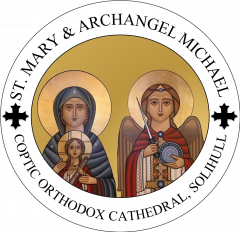Introduction to the Creed
We magnify you, O Mother of the true Light. We glorify you, O holy Virgin, Mother of God, for you have borne for us the Saviour of the whole world; He came and saved our souls. Glory to Thee Christ, our Master and our King, the pride of the Apostles, the crown of the martyrs, the joy of the righteous, the firmness of the churches and the forgiveness of our sins. We proclaim the Holy Trinity, One God. We worship Him. We glorify Him. Lord have mercy, Lord have mercy, Lord bless us. Amen.
The Creed of Faith
We believe in one God, the Father Almighty, Creator of heaven and earth, and all things, seen and unseen.
We believe in one Lord Jesus Christ, the Only-begotten Son of God, begotten of the Father before all ages. Light of Light; true God of true God; begotten, not created; of one essence with the Father; by Whom all things were made. Who, for us and for our salvation, came down from heaven, and was incarnate of the Holy Spirit and of the Virgin Mary, and became man. And He was crucified for us under Pontius Pilate; suffered and was buried. And on the third day He rose from the dead, according to the scriptures. He ascended into the heavens; and sits at the right hand of His Father. He shall come again in His Glory to judge the living and the dead; Whose Kingdom shall have no end.
Truly, we believe in the Holy Spirit, the Lord, the Life-Giver, Who proceeds from the Father; Who, with the Father and the Son, is worshipped and glorified; Who spoke by the prophets. And in One, Holy, Catholic (Universal) and Apostolic Church. We acknowledge one baptism for the remission of sins.
We await the resurrection of the dead, and the life of the age to come. Amen.
The “Nicene Creed” was formulated by St. Athanasius the Apostolic (the 20th Pope of Alexandria), a hero of the first Ecumenical Council of Nicaea in the 4th century (325 AD). This Council of 318 bishops approved this creed under the guidance of the Holy Spirit to refute the false teaching of Arius and his followers, who denied the Divinity of Christ. The creed was completed in the second Ecumenical Council of Constantinople (381 AD) convened by 150 bishops against Macedonious’ heresy against the divinity of the Holy Spirit. The third Ecumenical Council at Ephesus (431 AD), convened by 200 bishops against the heresy of Nestorius, added the introduction to the Creed.
The Nature of Jesus Christ
As formulated by Saint Cyril of Alexandria in the Council of Ephesus in 431 AD we can confess that in the one incarnate nature of the Word of God, two different natures, distinguished in thought alone, (τῇ θεωρίᾳ μόνῃ tê theôria monê) continue to exist without separation, without division, without change, and without confusion; that our Lord Jesus Christ is both fully Divine and fully Human.
In our Divine Liturgy we profess this in “The Confession” before partaking of the Eucharist; the priest saying:
“Truly I believe that His Divinity did not part from His Humanity not for an instant or a twinkle of an eye” and “His divinity united with His humanity without mingling without amalgamation and without alteration”.
